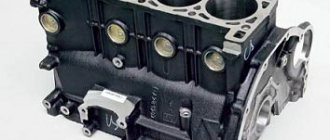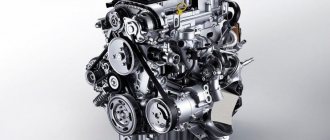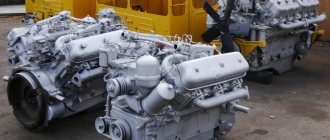Category: ENGINE
- Technical characteristics of the 126 Priora engine
- Crankshaft and piston group
- Gas distribution mechanism
- Engine lubrication system 126
- Cooling
- What is the difference between a 124 engine and a 126?
- Tuning 126 ldbufntkz
Lada Priora cars are equipped with a gasoline power unit. The 126 engine is externally similar to the previous model, but structurally they are different. Below are the characteristics of the power unit and its differences from the 124 model.
Technical characteristics of the 126 Priora engine
The motor has the following technical characteristics:
- Power unit brand – 21126;
- Engine type – four-stroke petrol;
- Number of working cylinders – 4;
- The arrangement of the working cylinders is in-line, vertical;
- The number of valves for each cylinder is two inlet and two exhaust;
- The gas distribution mechanism is driven by a belt, from a pulley installed in the front part of the crankshaft;
- Power plant power – 98 horsepower;
- Fuel supply system – distributed injection;
- The total volume of working cylinders is 1.6 liters;
- The curb weight of the power plant is 115 kg.
REFERENCE: The difference between the 126 and 127 engines is the maximum power indicator. With the same volume of 127, the engine has a power of 106 horsepower.
VAZ 2108 and VAZ 2109 - a whole era in Russian cars
Hatchbacks, which were popularly called “Chisels,” gained fame as reliable and durable cars; they were produced until our time, assembled in Ukraine for several years, but have completely lost their relevance in appearance and technology. Today you can buy on the secondary market an excellent version of the “Nine” of a completely new year of manufacture in perfect condition. The engine in this car has the following features:
- In the history of the model there were 1.1, 1.3 and 1.5 liter power units with a carburetor, as well as a 1.5 liter injection unit;
- all engines were protected from the influence of timing belt rupture, the valves in the power unit did not bend;
- the car had quite adequate engine reliability - this unit was the last one to break down in the car;
- All presented competitors at one time were distinguished by their advanced design, excellent comfort and other benefits.
At the very beginning of their production, VAZ 2109 and 2108 cars were a real revolution in the domestic automotive industry. Buyers of such cars have become real lucky ones in the eyes of their acquaintances and friends, exactly the same as buyers of the latest Mercedes models today. And there were certain logical reasons for this, such as the incredible reliability of the main components.
Crankshaft and piston group
126 Priora engine is equipped with a crankshaft with 5 main and four connecting rod journals. To prevent rapid wear in the rotation areas, the crankshaft is equipped with plain bearings. The sliding bearings are lubricated by oil supplied under pressure.
The pistons are made of light alloy. To prevent leakage of the working mixture from the combustion chamber into the crankcase of the power plant, the pistons are equipped with rings. Each piston has two compression rings. They are installed in special grooves.
To prevent oil from entering the working mixture, the pistons are equipped with oil scraper rings. The valves are equipped with oil protective caps. This design prevents lubricant from entering the working mixture.
Ways to solve the problem
Since the collision of pistons with valves has quite serious negative consequences, many car enthusiasts are interested in whether it is possible to influence this situation.
There are several methods that allow you to convert a valve-bending motor into a “plug-inless” one.
The simplest of them is installing pistons with grooves. By the way, on some VAZ engines this is how the problem with “sticking” is solved.
On the bottom of such pistons there are special recesses for valve plates. Due to this, the latter in the open position do not come into contact with the pistons installed at TDC.
But not all engines can be modernized in this way, for the reason that it is not always possible to find pistons with factory-made grooves to replace the “original” ones.
The second method is to independently make grooves on the piston. This method is suitable for those who have not found replacement “non-stick” pistons. But this method has a significant drawback - it is very difficult to make identical recesses on all pistons. As a result, an imbalance in the weight of the pistons may occur, which will affect the service life of the crankshaft. Also, grooves of different sizes can cause different compression in the cylinders, and this problem cannot be eliminated.
The third method is to increase the height of the combustion chamber. This is done by installing 2-3 gaskets under the head of the block. This method has a negative side - an increase in the volume of the combustion chamber, which entails a drop in compression, and as a result - a decrease in power and an increase in fuel consumption.
Gas distribution mechanism
The gas distribution mechanism is made in the form of 16 valves and two camshafts. The valves close the channels in the cylinder head through which the working mixture is supplied or exhaust gases are discharged.
The valve mechanism is controlled by camshafts. They have cams offset from the axis. As the cam rotates, it presses on the valve stem, thereby opening it. In the opposite direction, the valve moves under the action of a power spring. The camshafts are driven by the crankshaft. A toothed belt is provided for this purpose.
CAUTION: If the timing belt breaks, the pistons will bend the open valves. To avoid this, the timing belt must be changed regularly.
The valve mechanism is equipped with hydraulic compensators. This design eliminates the need to adjust the thermal gap. The valve cover is made of aluminum alloy. To prevent lubricant leakage, a gasket is installed between the cover and the cylinder head.
Malfunctions, causes, elimination
Since the 21126 engine is a 16-valve front-wheel drive design with an overhead camshaft position, it is prone to characteristic breakdowns:
| No startup when crankshaft rotates | 1) ignition coils are faulty 2) failure of electronic control 3) DPKV breakdown 4)fuel system malfunction | 1) Repair or replacement 2) flashing or replacing controllers 3) replacing the crankshaft position sensor 4) replacing the pressure regulator, cleaning the fuel module, injectors and ramp |
| The engine won't start | 1) cold 2) warmed up | 1) recharging the battery, cleaning the power system, replacing the coolant temperature sensor, replacing injectors, repairing the fuel management system 2) in addition to the above, replacing the air filter |
| The speed is floating XX | 1) vacuum hose connections 2) cylinder head gasket 3) clogged air filter | 1) replacing or tightening clamps 2)use a new gasket 3) cleaning or replacing the cartridge |
| Misfire in XX mode | 1)low compression 2) injector failure 3) failure of the ignition coils 4) faulty spark plugs | 1) replacing rings; valve stem seals2) installation of new injectors 3)repair or replacement 4) gap adjustment or replacement |
If you follow the requirements of the operating instructions and maintenance regulations, these troubles can be avoided.
Engine lubrication system 126
The 16 valve VAZ 126 engine, the characteristics of which are presented above, has a mixed-type lubrication system. Parts subject to high loads are lubricated with oil supplied under high pressure. Oil pressure is supplied by a gear-type pump.
REFERENCE: To avoid excess pressure, the system is equipped with a pressure relief valve. If the pressure is exceeded, the valve releases lubricant into the crankcase of the power plant.
Components not subject to high loads are lubricated by spraying oil. The parts of the gas distribution mechanism are lubricated by splashing. After splashing, the lubricant flows into the oil pan.
Let's move on to the cylinder block
We remove the pallet. Rotating the crankshaft as it is convenient for us, unscrew two bolts on each connecting rod cap. We use a TORX E10 head for this.
We take out the pistons along with the connecting rods. To do this, use the wooden handle of a hammer to press the connecting rod from below and lightly tap it to knock it up. We remove the old liners and buy new ones of the same size according to the markings on them. Here is another stone in AvtoVAZ’s garden, the owner has never climbed into the car from the interior or into the engine, but three pistons were of group “B” and one was “C”. It turns out that at the factory they re-sharpened one cylinder a little and simply put an enlarged piston there, no words. There are no options, we take group “C”, don’t sharpen the engine because of this. We will not touch the main liners either.
Cooling
The motor has a liquid cooling system. This allows it to be used under high loads regardless of ambient temperature. The cylinder block has a cooling jacket. It consists of channels through which coolant circulates.
The movement of liquid is carried out forcibly using a pump. The water pump is belt driven from the crankshaft of the power unit. The liquid is cooled in the radiator. The forced movement of air mass through the radiator honeycombs is carried out by a fan.
IMPORTANT: To avoid the occurrence of excess pressure as a result of increased coolant temperature, the cooling system is equipped with an expansion tank.
To quickly warm up the power plant in the winter, the cooling system is equipped with a thermostat.
At low coolant temperatures, it blocks a large circulation circle. After reaching the required temperature, the thermostat opens a large circulation circle.
Cylinder head repair
We mark all hydraulic compensators with numbers using an ordinary clerical touch and put them away. An ordinary magnet will help you pull them out. We dry out the valves and remove the oil seals (valve seals), the valves into scrap metal, the oil seals into the trash. We clean all channels. We take the head for grinding, just in case. After washing it again with kerosene after sanding and blowing it with air, we begin to assemble it.
We arrange the freshly purchased valves in the sequence in which they will stand in the cylinder head and begin to grind in one by one. Lubricate the valve stem with clean oil and apply lapping paste to the edge.
We insert the valve into place and put a valve grinding tool on the valve stem. The stores sell a device for manual lapping, but since this is the twenty-first century, we are mechanizing the process. We take the old valve and cut off the rod from it, select a rubber tube for it of such a diameter that it fits tightly.
The rod is in a reversible drill, one end of the tube is on it, the other is on the valve being ground in. At low speeds we begin to grind the valve, constantly change the direction of rotation and periodically press it to the seat or weaken the force. On average, the valve takes about twenty seconds. We take it out and wipe it. The valve is considered ground in if a uniform gray strip of at least 1.5 mm wide appears on the chamfer.
The same stripe should appear on the valve seat.
For a sixteen valve head, everything is the same, only there are twice as many valves. After lapping, all valves and seats are thoroughly wiped and washed with kerosene to remove any remaining lapping paste. We check for leaks. We tighten the old spark plugs and put all the valves in place. Pour kerosene and wait three minutes, if the kerosene does not run away all is well, otherwise we grind the valves on this cylinder.
We had to grind four valves again, after which the kerosene stopped flowing.
We stuff new valve seals.
We put the valves in place and dry them. Before doing this, lubricate the valve stems with clean oil. After lubricating it with clean oil, we put the hydraulic compensators in place and, covering them with a clean cloth, remove the head out of sight. We're done with the cylinder head.
What is the difference between a 124 engine and a 126?
Some motorists are wondering whether the 126 engine bends valves and how it differs from the 124 model? Motor 126 has the following differences from model 21124:
- Piston group. The weight of the piston group of the 126 model is lower than that of the 21124. The 124 model has pistons with specialized openings. If the gas distribution mechanism belt breaks, the open valves fall into the opening. In this case, the valves do not bend. 126 model bends the valve when the drive belt breaks;
- Sliding bearings. The main journal liners of the 126 model are thicker;
- Cylinder head gasket. 126 model is equipped with a metal gasket;
- Belt of the gas distribution mechanism. Belts 124 and 126 models differ in their design;
- Power. Power unit 21126 has higher power;
- Belt tension mechanism. The 21 126 engine has an automatic timing belt tensioning mechanism.
Maintenance
To ensure the declared resource, engine 21126 must be maintained in accordance with the regulations below:
- after 10,000 km, change the engine oil with the appropriate filter;
- The battery, attachment belts and crankcase ventilation can withstand 20,000 km;
- The tank cap, antifreeze and cooling system hoses, fuel and air filters cannot overcome the 40,000 mileage mark;
- It is recommended to replace the oxygen sensor after 100,000 km, and the timing belt after 180,000 km.
Complex design solutions have been added to the internal combustion engine, so it is necessary to meet the deadlines for replacing consumables.
Tuning 126 ldbufntkz
Some car owners perform engine 126 tuning on a Priora car. To do this, they flash the electronic control unit. Only qualified specialists can properly tune the electronic control unit. Incorrect ECU firmware can lead to incorrect operation of the power unit or complete failure of the electronic control unit.
From the above it follows that the power unit 21126 is a motor whose design differs from the previous model. The main differences are higher power, design features of the piston group, and gas distribution mechanism.
What cars was it in?
Immediately after its release, AvtoVAZ management began using the 21126 engine to power the following Lada models:
- Priora - from 2007 to 2016, all trim levels;
- Kalina - from 2007 to 2013, Luxury equipment;
- Kalina-2 - since 2013, on cars with automatic transmission;
- Granta - since 2011, Norma and Luxury equipment.
Lada Granta
Currently, Priora engines are equipped with 21127 engines, which have become the next version of the development of the 21126 internal combustion engine. On the other two models - Kalina-2 and Granta, this engine is used mainly with the JF414 automatic transmission from the Japanese manufacturer Jatco.











